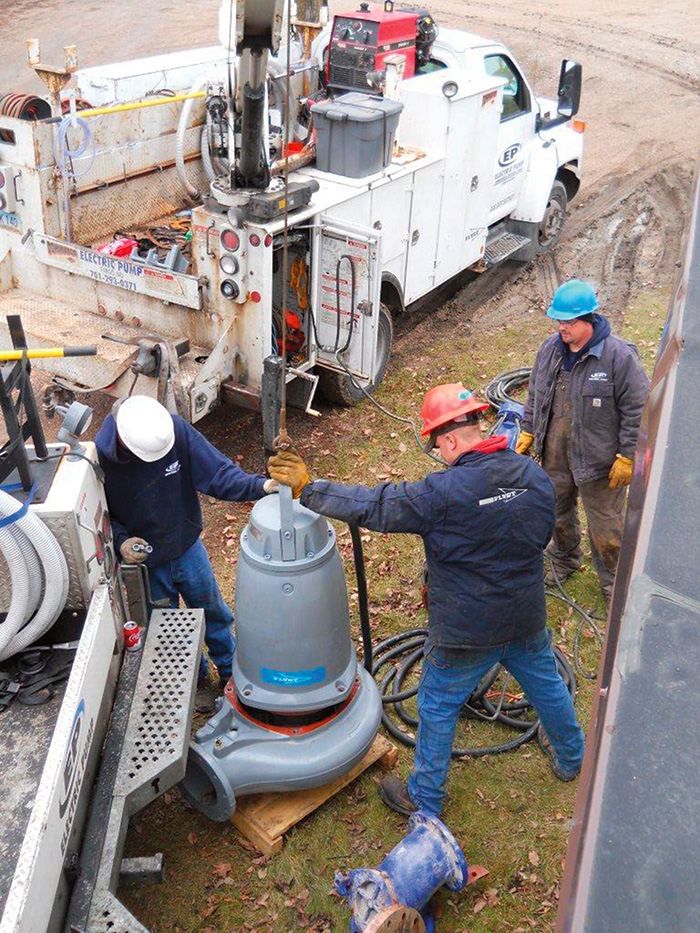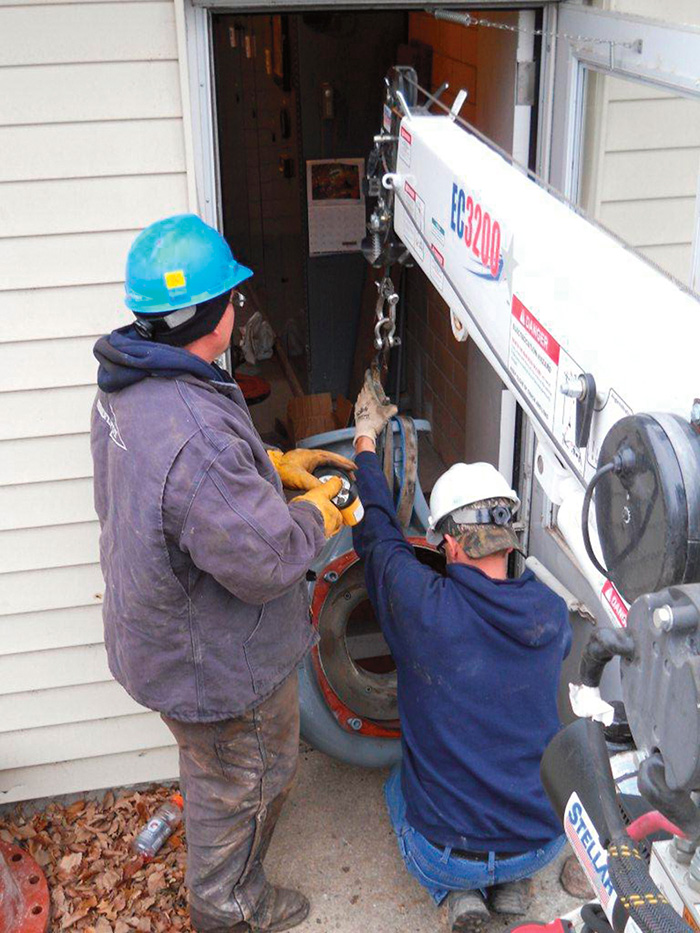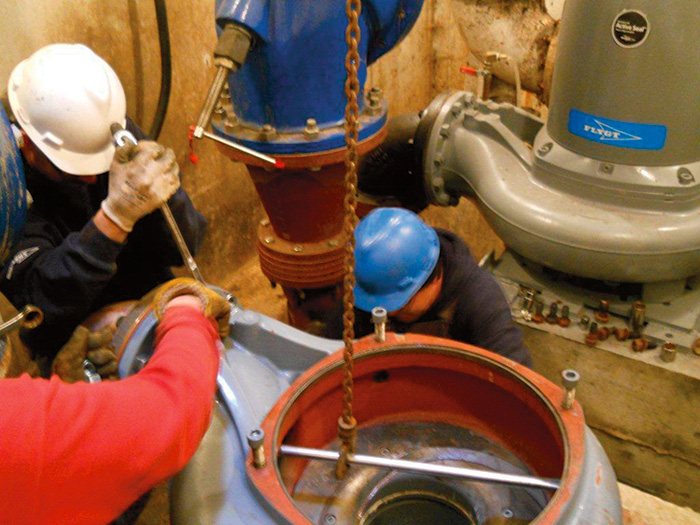A harmonic sound coming from within a pump station is not the sound municipal sewer system operators want to hear. From the rhythmic clunking inside the 4,000-gallon-per-minute Lift Station No. 9, Wayne Johnson knew he had an impending problem—perhaps a big one.
The superintendent of water and wastewater utilities for Thief River Falls, Minn., considers Lift Station No. 9 his most essential because it receives the entire sewage flow from the town’s 3,400 connections and operates immediately ahead of the three-pond treatment facility. The collection system that serves the 8,500 residents has 14 pump stations along 43 miles of 8-inch to 15-inch sewage collection lines. The 350-acre complex of ponds in Northwest Minnesota represents the state’s largest of its type and produces a higher-quality effluent, well below the minimum effluent standards discharged into the Red Lake River.
Johnson said that he initially hoped the audible clanging that day was caused by nothing more than a partially clogged pump. A set of related circumstances beyond just a clog could have left Lift Station No. 9 crippled with the risk of a bypass of 1.6 million gallons of raw sewage into the popular canoe and fishing stream that flows through the area, located 100 miles from Lake of the Woods.
His worst fears were realized when something more serious emerged at the heart of the noise in the lift station. It emanated from one of two 75-horsepower submersible pumps that the city had acquired four years earlier, before Johnson had become superintendent.

A three-man crew uncrates and prepares the new pump for installation after piping modifications.
“Lift station No. 9 at that time had received two 75-horsepower pumps while keeping a 38-year-old, 125-horsepower original equipment pump in place as a backup to operate during high flows through the dry-pit facility. The noise was so deafening from this [75-horsepower] pump that you couldn’t stand to be inside the station when it was running,” he recalled. “This was the second major problem with one of the pumps in two years of operation, and I was convinced I was dealing with a poorly engineered hydraulic design. The problem was further aggravated because of the manufacturer’s unresponsive customer service.”
The two 75-horsepower pumps had been acquired in 2005 after three rounds of bids to replace the two smaller pumps installed in 1974 as original equipment in the triplex station. The first two rounds of bids included installation and were rejected because the quotes exceeded the projected cost. A second round of bids separated the pumps and installation increments but was also rejected.
Finally, the replacement pumps were bid as a standalone, factory-direct quote without installation with the city deferring the work, hoping to negotiate a lower installation cost in the future. The price of the previously installed pump was significantly lower at bid time, so the pumps were purchased and held in a warehouse awaiting a favorable installation price. By 2009, the replacements could not be deferred any longer, and the units were finally set into Lift Station No. 9.

The crew maneuvers and lowers the volute for the replacement pump through the side door into the station.
Quality Overrides Cost
Most purchasing professionals will concede that the lowest-cost capital equipment does not ensure the highest quality. While in storage, the full warranty period had expired. Once in operation, one of these less expensive pumps failed within the first two years because of a bearing failure. A service mechanic was finally sent to the city after repeated contact with the manufacturer. The mechanic installed a new style of wear ring on the failed pump and added newly designed impellers on both units to ostensibly improve the hydraulics. The action bought some time but not a resolution.
“When the second pump failure occurred, it took months of additional contact with Germany to get a mechanic back to our station,” Johnson said. “It was a risky situation to be left with only the previously repaired pump operating in an alternating cycle with the 38-year-old original equipment pump intended only as a backup unit. We had left the last of the three original pumps in place for operation only in high-flow conditions induced by the system’s inflow and infiltration issues. A field mechanic blamed the problem on a turkey feather in the flow off our poultry plant. It would have cost $20,000 to repair the second failed pump, and by that time, I had simply lost all confidence in the pumps and the manufacturer’s follow-up service.”
Meanwhile, Lift Station No. 9 was left vulnerable, relying on the rebuilt pump that clogged as often as twice a week. The pump’s hydraulic design provides for open access of the impeller/wear ring to stationary volute wear ring interface. This open area was prone to becoming packed with debris, which can cause the jamming of the wear-ring interface and contribute to the loss of hydraulic efficiency and to frequent partial-to-full clogging of the pump hydraulic end. Fortunately, it was a dry year in the region that eliminated the need for a third pump to handle high flows. “But it was a horrible situation we were left with,” Johnson said.

Workers place and secure the volute before the remainder of the pump is received.
Emergency Replacements
Johnson turned to a representative of a factory-authorized brand of pumps that the utility had used exclusively in the other 13 stations along the collection system. A nationwide search located two 80-horsepower, self-cleaning, high-efficiency submersible pumps in Atlanta that were immediately available but would require modest modifications for use in the dry pit versus a fully-submersible installation.
To expedite the process, the city responded by declaring an emergency procurement upon recommendation of its consulting engineering firm. This allowed direct procurement without the time for a customary bid procedure and brought the pumps into service within three months. Large horsepower pumps are rarely held in inventory due to their cost, but the two found in Atlanta reduced the lead time to manufacture units, according to a spokesman. Only modest piping modifications were necessary for the pumps to mount vertically in Station No. 9’s dry pit.
The pumps feature highly efficient, clog-resistant hydraulics. The semi-open impeller and a relief groove in the volute reduce the risk of clogging and allow for the passage of solids to maintain consistent pumping efficiency, even under high-solids conditions. This feature is important in handling the effluent flow from the local turkey and other meat processing plants. The relief groove in the volute complements the self-cleaning impeller to maintain a consistent flow path through the pump. The concept eliminates most blockages and stringy material that can entangle on a conventional impeller and induce energy-sapping drag.
The expedited delivery and installation resolved the station’s immediate vulnerability and prevented a potential nightmarish bypass once the first replacement pump became operational in June 2012. Because of the recurring blockages, a second factory-manufactured submersible pump was added to the station in mid-October 2012.

